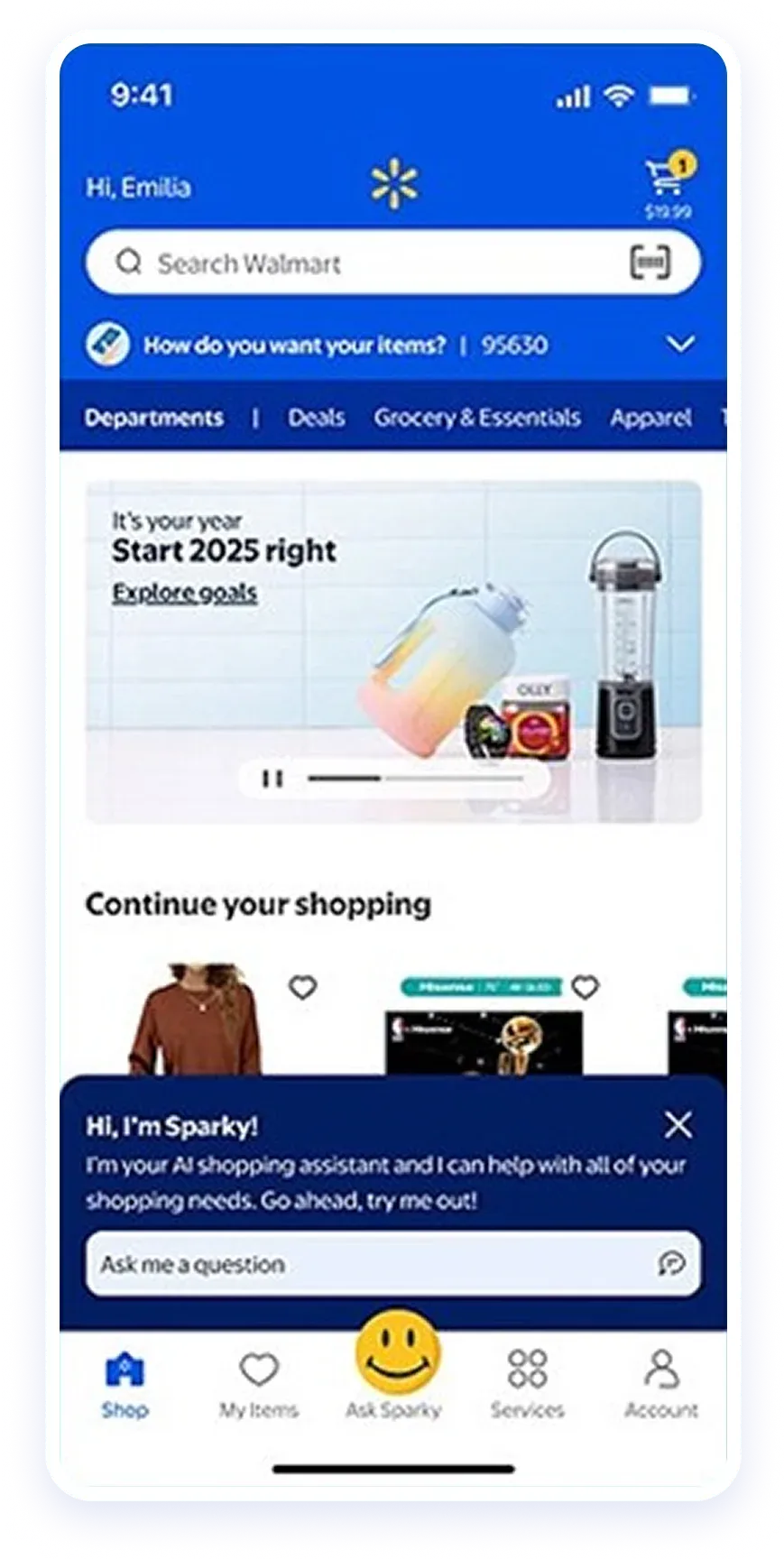Services
SERVICES
SOLUTIONS
TECHNOLOGIES
Industries
Insights
TRENDING TOPICS
INDUSTRY-RELATED TOPICS
OUR EXPERTS

September 04, 2025
Modern conversational AI solutions can easily handle complex interactions, capturing user intent and understanding the tone of a conversation to provide more relevant responses. This makes them useful in a variety of pre- and post-purchase scenarios.
Powered by large language models and ML-based recommendation engines, virtual assistants can replicate the personalized guidance provided by a real salesperson, bringing online shopping experiences closer to traditional in-store purchases. To achieve this, personal shopping assistants can hold dynamic conversations with customers and ask follow-up questions to better understand their needs, combine this information with customer data such as browsing history or past purchases, and offer tailored product recommendations.
Once users have made their decision and added a product to the virtual cart, AI-driven assistants can provide further suggestions, presenting a selection of complementary merchandise or upgraded versions of items that users were initially considering to help online retailers increase average order value. Compared to traditional recommender engines, AI assistants can anticipate untapped customer needs based on their purchase history analysis, behavior, and chat interactions and recommend complimentary or higher-value products at the right time. For example, if the customer was recently interested in travel accessories and has just added standard Bluetooth headphones to their cart, the assistant can suggest a more expensive noise-canceling model and highlight that it offers a better listening experience while traveling.
According to recent statistics, approximately 7 out of 10 online shopping carts are abandoned. Virtual shopping assistants can help recover lost sales and minimize cart abandonment by proactively engaging customers who have left items in their carts with targeted offers. For this, the assistant first estimates potential abandonment reasons and anticipates the most effective incentives based on the customer’s current cart and past behavior and interactions. Then, it can reach out to the customer at the right moment to address potential objections (such as clarifying shipping costs and providing alternative shipping options), make unique offers like personalized discounts or free shipping to motivate them to complete the transaction, or suggest cheaper deals for items with comparable features.
Increasing digital transaction volumes, coupled with a need for personalized 24/7 support availability and increasing labor costs, are putting a strain on retail companies’ customer support operations. That’s why many retail businesses are now complementing their customer support staff with AI chatbots and virtual assistants to handle service cases round the clock and efficiently resolve customer queries. These solutions are now increasingly applied to provide information on specific products or physical store hours, offer order status updates, and assist with user password resets, shopping list management, product returns and exchanges, and other operations.
| The virtual shopping assistant market is estimated to be valued at $1,103.9 million in 2025 and is projected to reach $8,083.6 million by 2032, growing at a CAGR of 32.9% | |
|---|---|
| Retail and ecommerce represent the leading sector in the global conversational AI market, which includes virtual assistants and AI chatbots, with a share of 21% |
| The top generative AI use cases that retailers are considering or implementing include personalized recommendations (66%), branded virtual assistant for customers (52%), and customer analysis and segmentation (50%) | |
|---|---|
| 48% of Millennials surveyed in 2025 reported using AI shopping assistants or ChatGPT to facilitate their online purchases | |
| 42% of consumers familiar with GenAI in online shopping have used this technology to resolve post-purchase queries | |
| GenAI-based conversational commerce can help reduce customer service costs by 30% and increase revenue through more personalized customer experiences |
| Around 49% of consumers aged between 25 and 34 and 48% of those aged 18 to 24 view AI-powered virtual shopping assistants positively. However, just over a quarter of people aged 65 to 74 have a positive attitude towards such interactions | |
|---|---|
| 66% of US consumers surveyed are strongly interested in trying GenAI-powered conversational commerce, potentially doubling its use | |
| 44% of consumers surveyed appreciate the help of AI shopping assistants in finding product information before making a purchase | |
| Over 80% of retail consumers value conversational AI tools for commerce that explain why they suggest certain products |
A US-based online household goods store teamed up with Itransition to build a virtual shopping consultant providing users with personalized product recommendations. The GenAI-powered solution can adjust suggestions based on real-time product availability and assist with checkout operations. After its implementation, the company achieved a 50% reduction in overall manpower effort for resolving customer queries.
Alexa Voice Shopping is a feature that enables users to make purchases on the Amazon ecommerce platform using voice commands through Alexa-enabled devices, such as Amazon Echo. Shoppers can ask Alexa to search for specific products, provide personalized suggestions, add items to their shopping list and cart, check out, and track their orders.

Agentforce is an agentic AI platform built into Salesforce that enables retailers to set up and deploy autonomous AI agents across a variety of business functions. Within their broad scope, these tools can also serve as virtual shopping assistants, helping customers explore new products, check order history, reorder the same items, and monitor order status.

Sparky is a GenAI-powered virtual assistant recently integrated into the Walmart mobile app and designed to enhance the online shopping experience. Walmart’s AI assistant can provide personalized recommendations, summarize product reviews, and compare purchasing options to help users make more informed decisions, as well as facilitating procedures such as reordering or service booking.

Image title: Sparky’s user interface
Image source: Walmart
Customers can get immediate assistance anytime thanks to virtual assistants operating outside of business hours.
Dynamic conversations with virtual assistants make the shopping journey more interactive and enticing.
AI assistants analyze user data and interactions to offer relevant product recommendations based on customer needs.
Through the automation of routine tasks like returns management or cart recovery, virtual assistants help mitigate customer service workload and cut operational costs.
Virtual assistants encourage purchases and help reduce cart abandonment via personalization, boosting sales and average order value.
Businesses can extract actionable insights from each interaction between AI assistants and users to refine their strategies for assortment, replenishment, and other key retail aspects.
Unlike human agents, virtual assistants can handle multiple customer queries at once, especially during peak seasons.
Guided by a virtual shopping assistant, customers make more informed decisions, buying products that truly meet their expectations.
Issue | Recommendations | |
|---|---|---|
Risk of inaccuracies |
Virtual shopping assistants are valuable tools as long as they provide users with accurate and relevant
information. If your assistant consistently suggests products that don’t match customers’ taste or aren’t
currently available, conversions will drop.
|
|
Cumbersome interactions |
While inaccurate responses certainly annoy users, there are many other factors that can ruin the user
experience and lead to abandonment, including excessively long conversation flows.
|
|
Data privacy & security concerns |
AI systems’ need to process large volumes of data, including personal information, can raise concerns
among both the public and regulatory agencies about how such data is collected and handled, as well as
drawing the attention of hackers and fraudsters.
|
|
Itransition provides an extensive range of AI services and solutions to help retailers engage their audience and scale their business operations.

Our specialists build chatbots, virtual assistants, AI agents, and many other artificial intelligence solutions that combine top performance with strict regulatory compliance, taking care of front-end and back-end development, software integration, QA and testing, and post-launch support.
We provide expert advisory across each step of the artificial intelligence implementation lifecycle, assisting your company with project planning and supervision, software design, and user adoption to maximize the value of your AI solution.

With the exponential rise of ecommerce over the past decade, retailers have struggled to combine the personalized care offered by in-store salespeople and the scalability of digital solutions. Rule-based chatbots aimed to bridge this gap, but could barely mimic the public relations skills of a human agent. AI-powered virtual shopping assistants, on the other hand, offer the best of both worlds: realistic, human-like interactions and instant, 24/7 support to thousands of customers.
For companies looking to advance their retail strategy by implementing a conversational AI solution, Itransition offers its strategic guidance and proven delivery capabilities.
Nowadays, virtual shopping assistants primarily draw on generative AI and large language models like OpenAI’s GPT and Google Gemini, along with more “traditional” AI technologies such as machine learning and natural language processing (NLP) in particular. Voice assistants are built on core NLP technologies, including speech recognition and synthesis, to support spoken language interactions.
Reflecting current trends in conversational AI, AI chatbots typically focus on tasks such as question answering or handling simple queries, whereas virtual shopping assistants can handle more complex tasks, such as assisting users with product orders and related transactions. However, the boundary between these categories is getting more and more blurred over time, due to the rise of GenAI and its incorporation into both virtual assistants and bots.
The choice mostly depends on your business scenario. Custom assistants are a great option for businesses
requiring tailored functionality and full control over data management and security. However, this comes with
higher upfront costs and a potentially lengthy development process, especially for training AI models.
Building virtual shopping assistants on top of AI platforms from leading cloud providers, such as
Azure Assistant and Amazon Q, can be a better option for companies looking to minimize initial investment and
speed up deployment. Furthermore, these platforms provide artificial intelligence algorithms and models
optimized for maximum performance, along with a robust cloud infrastructure to make your solution more
scalable.
A custom virtual assistant development project typically comprises the following key steps:

Insights
Discover top applications, real-life examples, and key trends of machine learning in ecommerce, along with some best practices to streamline its adoption.

Service
Itransition delivers reliable, secure, and highly scalable AI agents to streamline complex business processes and assist your audience across all channels.

Insights
Discover key capabilities, integrations, and benefits of ecommerce CRM software, along with the best CRM platforms for this industry and selection tips.

Insights
Explore key applications, real-world examples, and benefits of machine learning in retail, along with best practices to facilitate its implementation.

Case study
Learn how Itransition delivered retail BI and deployed an ML-based customer analytics solution now processing 10TB of data.

Insights
Explore how virtual stores bridge the gap between online and in-store shopping, helping retailers better engage with customers through immersive experiences.